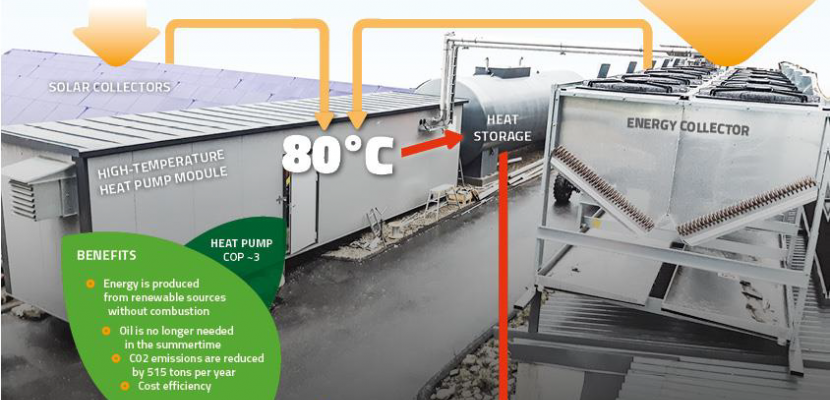Image

Hybrid solar thermal and air heat pump system for district heating
Published on 12 November 2020

Finland
Pohjois- ja Itä-Suomi
This is the good practice's implementation level. It can be national, regional or local.
About this good practice
Suur-Savon Sähkö, a local energy company, had a problem with their biomass heating plant. The plant was covering the local district heating need in winter but the heating load in summer was so low that the large plant could not be run at such a low partial load. Therefore, in the summertime, the small heating load had to be covered by an older oil-fired boiler.
To cover the small summertime load, a new hybrid solar thermal system was devised by Calefa Oy, a Päijät-Häme based energy efficiency systems provider, which uses panels that gather solar heat which is then used as a heat source for a heat pump. The heat pump is devised so that it can also use ambient air as a heat source and is fitted with a heat storage tank so that it continues to function with high efficiency even in the night-time when temperatures cool down and sun no longer shines.
The main stakeholders of the project are the energy company, its customers and the municipality of Puumala, as well as, the local parish that donated the land on which the solar collectors are placed.
To cover the small summertime load, a new hybrid solar thermal system was devised by Calefa Oy, a Päijät-Häme based energy efficiency systems provider, which uses panels that gather solar heat which is then used as a heat source for a heat pump. The heat pump is devised so that it can also use ambient air as a heat source and is fitted with a heat storage tank so that it continues to function with high efficiency even in the night-time when temperatures cool down and sun no longer shines.
The main stakeholders of the project are the energy company, its customers and the municipality of Puumala, as well as, the local parish that donated the land on which the solar collectors are placed.
Resources needed
The system runs itself almost maintenance-free. Design and delivery by an external energy efficiency system turnkey solutions provider Calefa. Total costs were around 650 000 €. System received aid from ministry of industry for novel energy efficient technologies covering 30 % of investment costs.
Evidence of success
Oil use has reduced by 30 000 litres a year and CO2 emissions by 515 tons per year. The system has proven to work even in the wintertime if the weather is sunny.
Potential for learning or transfer
System like this has the potential to work better in countries with longer summers than Finland. Addition of heat pump makes solar thermal heating more efficient and allows for high temperatures to be achieved while still being very energy efficient. However, countries with better solar thermal potential also have less heating demand. However, the company points out that the system would be even more efficient if coupled with a demand for cooling, which the heat pumps could supply simultaneously with heating. As heat pumps benefit from cheap electricity, the system is well suited to exploit power-to-X, producing heat during periods of cheap electricity, which can also be stored in the heat storage, making it cheaper to run and increasing savings.
Similar systems could be used for heating industrial processes by combining solar thermal collectors with heat pumps. New high-temperature heat pumps such as the one used in this plant open up much new potential for heat pump applications.
Similar systems could be used for heating industrial processes by combining solar thermal collectors with heat pumps. New high-temperature heat pumps such as the one used in this plant open up much new potential for heat pump applications.
Further information
Website
Good practice owner
You can contact the good practice owner below for more detailed information.
Organisation
Lab university of applied sciences

Finland
Pohjois- ja Itä-Suomi
Contact
RDI specialist
